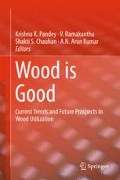Abstract
The present study was carried out in four Artocarpus species namely A. chaplasha, A. heterophyllus, A. lakoocha and A. nitidus collected from the forests of Assam and Mizoram, NE India. The main objective of study was to evaluate variation in anatomical features among species both qualitatively and quantitatively. All selected species had diffuse-porous wood with indistinct rings, vessels solitary or in radial multiple of 2–3, simple perforation plate, intervessel pits alternate, laticifers in the form of black streaks among fibres and rays, vessel ray pits similar to intervessel pits, vasicentric and lozenge aliform parenchyma. In addition, presence of ray flecks and latex ducts in rays of A. chaplasha, gelatinous fibres in A. chaplasha and A. nitidus, sheath cells in A. lakoocha and A. nitidus, axial parenchyma confluent and winged aliform in A. heterophyllus were observed. Tissue proportions among species showed maximum percentage of fibres in A. nitidus, vessel and rays in A. heterophyllus and parenchyma in A. nitidus, respectively. Maximum vessel frequency was observed in A. chaplasha, while maximum rays were recorded in A. nitidus and A. lakoocha. Quantitative characters showed statistically non-significant differences within species, while these characters exhibited significant differences among species. Correlation for most of the anatomical characteristics was too weak to be significant, but the correlation of specific gravity was positively significant with ray width and negatively significant with fibre diameter.
Access this chapter
Tax calculation will be finalised at checkout
Purchases are for personal use only
References
Anoop EV, Ajayghosh V, Pillai H, Soman S, Sheena VV, Aruna P (2011) Variation in wood anatomical properties of tree species grown in research trials at LRS, Thiruvazhamkunnu, Palakkad, Kerala. J Ind Acad Wood Sci 8(2):100–105
Berg CC (2001) Moreae, Artocarpeae, and Dorstenia (Moraceae) with introduction to the family and Ficus and with additions and corrections to Flora Neotropica Monograph 7, New York
Berg CC, Corner EJH, Jarrett FM (2006) Moraceae—genera other than Ficus. National Herbarium Nederland, Leiden
Carlquist S (2001) Comparative wood anatomy. In: Systematic, ecological and evolutionary aspects of dicotyledon wood. Springer, Berlin, p 448
Clement WL, Weiblen GD (2009) Morphological evolution in the Mulberry family (Moraceae). Syst Bot 34:530–552
Datwyler SL, Weiblen GD (2004) On the origin of the fig: phylogenetic relationships of Moraceae from ndhF sequences. Am J Bot 91:767–777
Gamble JS (1922) A manual of Indian timbers. IBD, Dehradun, p 868
Committee IAWA (1989) IAWA list of microscopic features for hardwood identification. IAWA Bull ns 10(3):221–332
Pande PK, Negi K, Singh M (2005) Intra- and inter-species wood anatomical variation in Balau Group of Shorea of Peninsula. Ind For 131(8):1041–1048
Purkayastha SK (1996) A manual of Indian timbers. Sribhumi Publication, Calcutta, p 614
Raturi RD, Chauhan L, Gupta S, Rao RV (2001) Indian woods—their identification, properties & uses, vol VI. Euphorbiaceae to Salicaceae, ICFRE, Dehradun, p 197
Sharma CL, Sharma M, Carter MJ, Kharkongor BM (2011a) Inter species wood variation of Castanopsis species of Meghalaya. J Ind Acad Wood Sci 8(2):124–129
Sharma M, Sharma CL, Kharkongor BM, Carter MJ (2011b) Wood anatomical variation in some species of Quercus of Meghalaya. J Ind Acad Wood Sci 8(2):152–157
Sharma M, Sharma CL, Lalmalsawma M, Singh MK, Gogoi BR (2014) Wood anatomy of some Ficus species of Mizoram, NE India with reference to their identification. Int J Bot Res 4(2):19–30
Singh MK, Sharma M, Sharma CL (2013) Wood anatomical variations in some Terminalia species of Assam. Int J Bot Res 3(2):13–18
Topper SMC, Koek-Noorman J (1980) The occurrence of axial latex tubes in the secondary xylem of some species of Artocarpus J.R. & G. Forster (Moraceae). IAWA Bull ns 1(3):113–119
Acknowledgements
The authors are thankful to the Director, NERIST for providing necessary laboratory facilities, help, and encouragement for carrying out the research work.
Author information
Authors and Affiliations
Corresponding author
Editor information
Editors and Affiliations
Rights and permissions
Copyright information
© 2017 Springer Nature Singapore Pte Ltd.
About this paper
Cite this paper
Singh, M.K., Sharma, C.L., Sharma, M. (2017). Comparative Wood Anatomy of Four Artocarpus Species of North East India with Reference to Their Identification. In: Pandey, K., Ramakantha, V., Chauhan, S., Arun Kumar, A. (eds) Wood is Good. Springer, Singapore. https://doi.org/10.1007/978-981-10-3115-1_8
Download citation
DOI: https://doi.org/10.1007/978-981-10-3115-1_8
Published:
Publisher Name: Springer, Singapore
Print ISBN: 978-981-10-3113-7
Online ISBN: 978-981-10-3115-1
eBook Packages: Biomedical and Life SciencesBiomedical and Life Sciences (R0)

